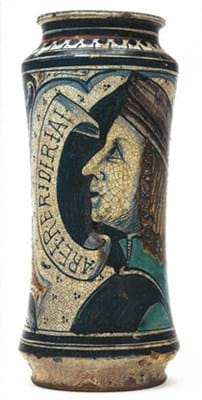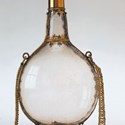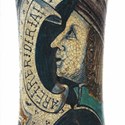The collection of drinking vessels and drink-related items had been assembled in the mid-20th century by the founders of drinks giant Seagrams. Seagrams was acquired a few years ago by the publishing company Vivendi, which has been gradually selling off its corporate collections, of art photography and other objects, many of which were housed in Mies van der Rohe's iconic Seagram building in New York. A wide international spread of auction houses have been used by Vivendi to sell Seagram material. ArtCurial's 74-lot sale on March 15 simply the latest in an international line that includes Sotheby's, Christie's and the Boston rooms of Skinner.
The 120 lots of high Renaissance Italian maiolica offered on the afternoon of the same day featured material from all the major 15th and 16th century workshops. Catalogued as The Italika collection, this material had been assembled over a 30-year period by two Italian collectors, Nicolo Scibilia and Rosario Calco Labruzzo. It was interesting that a Parisian rather than an Italian auction venue was chosen.
Of the two events it was the Seagram collection which met with the warmer response. All bar half a dozen lots sold (although with just a couple of exceptions the prices were pretty much par for the course). But at least it did get away, unlike the bulk of the Italika maiolica. ArtCurial had been talking in terms of a total of around €2.5m-3m for this assemblage, but with just 30 lots managing to change hands it ended up achieving only a fraction of that sum, just €574,600. Some of the trade felt the estimates were pretty steep and if so this would have limited the potential market. Whatever the reason, the room appears to have given the sale the thumbs down.
The Seagram drinking collection was a somewhat eclectic assemblage united by the common bibulous theme. This represented only the Seagram's European material, the American element of 19th century mould blown glass remained in the United States. Rather than focusing on one area, this European element attempted to give a representational nod in the direction of drink-related objects across the Continent during the 17th and 18th centuries. It took in drinking glasses, stoneware and faience jugs and bottles, and metalwares ranging from a 18th century silver corkscrew to a brass gourd, usually featuring an example or two of each type. Most of the pieces were supplied to Seagram by the New York Gallery Blumka Antiques.
There was relatively little surprise about the most sought-after entry. A 13in (33cm) high, clear blown glass pilgrim flask with gilt bronze mounts attributed to France or Italy and dated to the 17th century had been picked out to illustrate the catalogue cover. It duly trebled its estimate at €38,000 (£26,390). A German pewter-mounted faience jug, 12in (30cm) high, with elaborate polychrome decoration of the goddess Flora in a scrolling cartouche attributed to Bartholemew Seuter of Augsburg and dated to c.1720, made €35,000 (£24,300). Again a price comfortably over estimate.
Low Countries flute
Plenty of pieces were making pretty much what was expected or getting away a little under predictions, such as an early 17th century 11in (28cm) high façon de Venise flute from the Low Countries with a blue and clear glass winged stem, which made £4200 (£2920), and a 121/5in (32cm) high 17th century German humpen from Franconia dated 1685 and painted in coloured enamels with a view of the Ochsenkopf Mountain that fetched €4000 (£2780). The low-key demand for the Germanic glass was not that surprising given that this sector of the market has been very sluggish of late, but it might have been less expected for façon de Venise and Venetian wares as these have been rather more buoyant recently.
By coincidence, the best-selling piece in the Italika auction also had a Blumka provenance. This was a 12in (30cm) high albarello from Naples dated to the second half of the 15th century. This is painted with a profiled portrait of a young man in a toque-shaped hat and had an inscription thought to be related to King Alphonse of Aragon. It is similar to an example now in the Louvre. ArtCurial had flagged it up as one of the stars of the collection and it surpassed its estimate, selling for €67,000 (£46,530).
Seagram collection enjoys steady flow, as maiolica drips slowly
CERAMICS SALES IN FRANCE £1 = €1.44A collection of drink-related objects and another devoted to Italian Renaissance maiolica were two very different single-owner properties on offer on the same day at the Paris auction house ArtCurial (17.5/10% buyer’s premium) last month.








